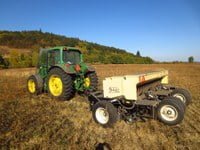Wet Prairie Restoration
by Tom Kaye — last modified Apr 29, 2013
IAE partners with state and federal agencies on wetland restoration at the EE Wilson Wildlife Area

Prairies have become a rare landscape in Oregon as a result of agriculture and development. What remains tends to be degraded, full of introduced species and requires a dedication of many resources to bring back these ever important native habitats. The Institute for Applied Ecology (IAE) is working hard to restore two wet prairies at the Oregon Department of Fish and Wildlife (ODFW) EE Wilson Wildlife Area, just north of Corvallis. Ultimately, we aim to provide native prairie habitat for wildlife and boost populations of rare and endangered plants.
This project began in 2012, when IAE, ODFW and subcontractors mowed and sprayed invasive and non-native species to prepare the ground for native grasses and wildflower forbs. Pipit prairie was burned to reduce grass thatch to provide an ideal seed bed for the native forbs.
In October, we used a no-till drill to sow Pipit prairie with nearly 200 pounds of forbs, with one-third devoted to Nelson’s checkermallow (Sidalcea nelsoniana) seed – the sowing at this site is part of a larger scale recovery effort of this threatened species in the Willamette Valley. Two dozen species were chosen for the mix, including species with different habitat preferences, to suit the subtle differences in topography of the field.
In November, IAE returned to Pipit and planted over 1000 plugs of Nelson’s checkermallow and 3000 other forbs, including camas (Camassia leichtlinii), Oregon geranium (Geranium oreganum) and Oregon iris (Iris tenax). The fields are starting to look more natural, and a Western meadowlark was seen checking out Pipit prairie. Hopefully this is a sign of things to come.
Spring will bring the fragrant popcornflower (Plagiobothrys figuratus) which thrives in ephemeral pools that hold water seasonally, and farewell-to-spring (Clarkia amoena) which prefers the more upland soils. We also sowed nearly 400 pounds of native grasses at West Check Station with different seed mixes to suit the wet prairie, upland prairie and fire lines. This field will be ready for its forbs in 2014.
“I have a lot of respect for farmers and their tractor driving skills,” said Peter Moore, one of IAE’s restoration ecologists. “It takes a lot of concentration to drill a field efficiently and not end up with gaps between the rows, especially at the corners!”
Funding for this work was provided by ODFW’s Willamette Wildlife Mitigation Program, as well as Oregon Watershed Enhancement Board (OWEB) and US Fish and Wildlife Service (USFWS) grants for the Nelson’s checkermallow recovery project. Many thanks to ODFW staff at EE Wilson Wildlife Area for their support of the project.
